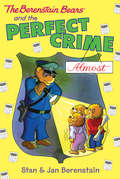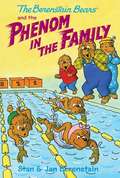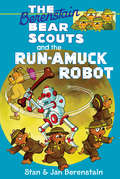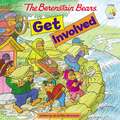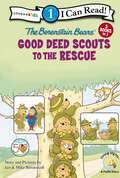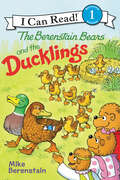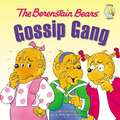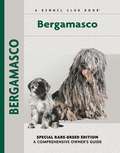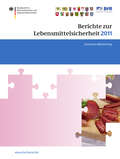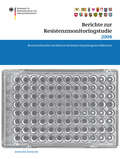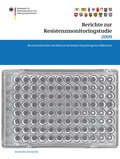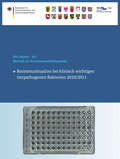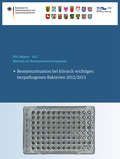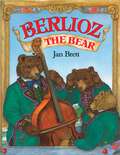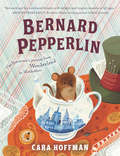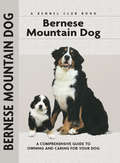- Table View
- List View
Berenstain Bears Chapter Book: The Perfect Crime (Almost)
by Stan Berenstain Jan BerenstainBear Country School is celebrating its 200th birthday, and Brother and Sister Bear can't wait to have a good time. But before the parties start, the cubs stumble upon an antique document that may have been faked! Can the cubs get to the bottom of this historic whodunit?
Berenstain Bears Chapter Book: The Phenom in the Family
by Stan Berenstain Jan BerenstainThere's a brand-new pool at Bear Country School, and all the cubs are raring to try out for the swim team. No one is more surprised than Sister Bear when she outswims every cub in every event--even the butterfly stroke! With visions of Bearlympics gold dancing in Papa Bear's furry head, he insists on being Sister's personal trainer as she prepares for the big meet. It's a decision that everyone in the Bear family will live to regret, for Papa--armed with his trusty clipboard, whistle, and stopwatch--will stop at nothing to achieve victory! Whoever said it doesn't matter whether you win or lose, it's how you play the game . . . that sure wasn't Papa!
Berenstain Bears Chapter Book: The Run-Amuck Robot
by Stan Jan BerenstainWatch out, Bear County—a there's a robot on the loose! When Professor Actual Factual invents a walking, talking bear replica robot, everyone is excited. That is, until they realize the robot has a mind of its own.
Berenstain Bears Chapter Book: The School Scandal Sheet (Berenstain Bears Ser.)
by Stan Berenstain Jan BerenstainThe cubs learn about freedom of the press--and responsibility--when they create an underground school newspaper, in a timely story that features cartoon-style illustrations and large type to ease beginning readers' transition to chapter books.
Berenstain Bears Get Involved (Berenstain Bears/Living Lights: A Faith Story)
by Jan Berenstain Mike BerenstainA storm hits Bear country, and Bear Country might flood! It&’s up to the Bear family and the rest of the rescue team from the Chapel in the Woods to come together and save their community.
Berenstain Bears Good Deed Scouts to the Rescue: Level 1 (Berenstain Bears/Living Lights: A Faith Story)
by Jan Berenstain Mike BerenstainYoung readers will learn just how important it is to serve your community and one another in The Berenstain Bears Good Deed Scouts to the Rescue. Written in Level One I Can Read™ standards, this three-book collection of titles from the Berenstain Bears Living Lights I Can Read series is sure to please young, emergent readers practicing early reading skills.The Berenstain Bears Good Deed Scouts to the Rescue is perfect for:Increasing early reading skills with simple vocabulary and age-appropriate themesReading out loud at home, in the classroom, or at story timeFans of the Berenstain BearsServing as a springboard for discussion on service to the communityThe Berenstain Bears Good Deed Scouts to the Rescue is an addition to the Living Lights™ I Can Read series that:Features the hand-drawn artwork of the Berenstain familyContinues in the much-loved footsteps of Stan and Jan Berenstain in this Berenstain Bears series of booksIs part of one of the bestselling children&’s book series ever created, with more than 250 books published and nearly 300 million copies sold to dateIncluded in this collection are The Berenstain Bears Kitten Rescue, The Berenstain Bears Neighbor in Need, and The Berenstain Bears Little Lost Cub.
Berenstain Bears and the Ducklings (I Can Read Level 1)
by Mike BerenstainJoin the Berenstain Bears as they prepare a warm welcome for the newborn ducklings in this sweet springtime addition to the classic New York Times bestselling series.After the Berenstain Bears help Farmer Ben with his chores, a pair of ducks mistakenly follow them home. But what comes next is a huge surprise for everyone—Brother and Sister find a nest filled with eggs!Berenstain Bears and the Ducklings is a Level One I Can Read book, which means it’s perfect for children learning to sound out words and read full sentences.
Berenstain Bears' Gossip Gang (Berenstain Bears/Living Lights: A Faith Story)
by Jan Berenstain Mike BerenstainYoung readers will be interested to read about Sister&’s experience with gossip and how it can be hurtful in this addition to the Living Lights™ series of Berenstain Bears books. Children will learn about the importance of kindness, character, and how gossip can be hurtful.The Berenstain Bears&’ Gossip Gang—part of the popular Zonderkidz Living Lights series of books—is perfect for:Early readers ages 4-8Reading out loud in classrooms, during story time, and at home or bedtimeBirthday gifts, Easter, holiday gift giving, or as a new addition to your e-librarySparking meaningful conversations about kindness and the importance of not participating in gossipThe Berenstain Bears&’ Gossip Gang is an addition to the Living Lights™ series that:Features the hand-drawn artwork of the Berenstain familyContinues in the much-loved footsteps of Stan and Jan Berenstain in this Berenstain Bears series of booksIs part of one of the bestselling children&’s book series ever created, with more than 250 books published and nearly 300 million copies sold to date
Berenstain Bears, Do Not Fear, God Is Near: Level 1 (I Can Read! / Berenstain Bears / Living Lights: A Faith Story)
by Stan Berenstain Jan Berenstain Mike BerenstainYoung readers will begin sounding out words and reading simple sentences in this Level One I Can Read addition to the Living Lights™ series of Berenstain Bears books. Children will learn why it is important to stop being afraid and trust in God. The Berenstain Bears, Do Not Fear, God Is Near—part of the popular Zonderkidz Living Lights series of books—is perfect for:Early readers ages 4-8Teaching new readers how to sound out words and use context cluesSparking intentional conversations about God being in control and the importance of trusting himBirthday gifts, Easter, holiday gift giving, or as a new addition to your e-library The Berenstain Bears, Do Not Fear, God Is Near is an addition to the Living Lights™ series that:Features the hand-drawn artwork of the Berenstain familyContinues in the much-loved footsteps of Stan and Jan Berenstain in this Berenstain Bears series of booksIs part of one of the bestselling children&’s book series ever created, with more than 250 books published and nearly 300 million copies sold to date
Berenstain Bears, Faith Gets Us Through: Level 1 (I Can Read! / Berenstain Bears / Living Lights: A Faith Story)
by Stan Berenstain Jan Berenstain Mike BerenstainYoung readers will begin sounding out words and reading simple sentences in this Level One I Can Read addition to the Living Lights™ series of Berenstain Bears books. Children will learn about the core value of faith as they read about Papa and the Good Deed Scouts&’ cave-exploring adventure.The Berenstain Bears, Faith Gets Us Through—part of the popular Zonderkidz Living Lights series of books—is perfect for:Early readers ages 4-8Teaching new readers how to sound out words and use context cluesSparking intentional conversations about trust, commitment, and the importance of biblical valuesThe Berenstain Bears, Faith Gets Us Through is an addition to the Living Lights™ series that:Features the hand-drawn artwork of the Berenstain familyContinues in the much-loved footsteps of Stan and Jan Berenstain in this Berenstain Bears series of booksIs part of one of the bestselling children&’s book series ever created, with more than 250 books published and nearly 300 million copies sold to date
Berenstain Bears, God Made the Colors: Level 1 (I Can Read! / Berenstain Bears / Living Lights: A Faith Story)
by Stan Berenstain Jan Berenstain Mike BerenstainYoung readers will begin sounding out words and reading simple sentences in this Level One I Can Read addition to the Living Lights™ series of Berenstain Bears books. Children will learn about all of the colors that exist in the world because of God.The Berenstain Bears, God Made the Colors—part of the popular Zonderkidz Living Lights series of books—is perfect for:Early readers ages 4-8Teaching new readers how to sound out words and use context cluesSparking educational conversations about the large array of colors God createdThe Berenstain Bears, God Made the Colors is an addition to the Living Lights™ series that:Features the hand-drawn artwork of the Berenstain familyContinues in the much-loved footsteps of Stan and Jan Berenstain in this Berenstain Bears series of booksIs part of one of the bestselling children&’s book series ever created, with more than 250 books published and nearly 300 million copies sold to date
Berenstain Bears, God Made the Seasons: Level 1 (I Can Read! / Berenstain Bears / Living Lights: A Faith Story)
by Stan Berenstain Jan Berenstain Mike BerenstainYoung readers will begin sounding out words and reading simple sentences in this Level One I Can Read addition to the Living Lights™ series of Berenstain Bears books. Children will learn about the four seasons – winter, spring, summer, and fall.The Berenstain Bears, God Made the Seasons—part of the popular Zonderkidz Living Lights series of books—is perfect for:Early readers ages 4-8Teaching new readers how to sound out words and use context cluesSparking educational conversations about the four seasons and the fun you can have each seasonThe Berenstain Bears, God Made the Seasons is an addition to the Living Lights™ series that:Features the hand-drawn artwork of the Berenstain familyContinues in the much-loved footsteps of Stan and Jan Berenstain in this Berenstain Bears series of booksIs part of one of the bestselling children&’s book series ever created, with more than 250 books published and nearly 300 million copies sold to date
Bergamasco
by Donn De Falcis AndreoliAuthored by expert breeder Maria Andreoli, founder of the famed Dell'Albera Kennels in Italy, and Donna DeFalcis, the first American breeder of the Bergamasco, this Special Rare-Breed Edition provides everything a new owner needs to know about acquiring a well-bred puppy, coat care, temperament, training and more. As a much-needed resource for owners, this new book offers a complete history of the breed, accompanied by over 135 unique photographs, as well as an authoritative text to help the read to better understand, train and raise this fascinating breed.
Berichte zur Lebensmittelsicherheit 2011: Zoonosen-Monitoring (BVL-Reporte #7,7)
by Saskia DombrowskiZoonosen sind Krankheiten bzw. Infektionen, die auf natürlichem Weg direkt oder indirekt zwischen Menschen und Tieren übertragen werden können. Mit Zoonoseerregern kontaminierte Lebensmittel stellen eine wichtige Infektionsquelle für den Menschen dar. Beim Zoonosen-Monitoring werden repräsentative Daten über das Auftreten von Zoonoseerregern in Lebensmitteln, Futtermitteln und lebenden Tieren erfasst, ausgewertet und veröffentlicht. Weiterhin dient das Zoonosen-Monitoring der Überwachung von Antibiotikaresistenzen bei Zoonoseerregern und anderen Mikroorganismen.
Berichte zur Resistenzmonitoringstudie 2008: Resistenzsituation bei klinisch wichtigen tierpathogenen Bakterien Berichte gemäß § 77 Abs. 3 AMG (BVL-Reporte #7.1)
by Saskia DombrowskiJede Gabe von Antibiotika an Tiere fördert die Selektion bestehender Resistenzen und die Entwicklung neuer. Damit keine oder möglichst wenig resistente Keime in die menschliche Nahrungskette gelangen, braucht es Strategien. Der umfassende Bericht über Antibiotikaresistenzen bei klinisch wichtigen tierpathogenen Bakterien bildet dabei die Grundlage zur Entwicklung nachhaltig wirksamer Managementmaßnahmen. Die vom Bundesamt für Verbraucherschutz und Lebensmittelsicherheit erhobenen Daten ermöglichen bundesweit koordinierte Vorgehensweisen.
Berichte zur Resistenzmonitoringstudie 2009: Resistenzsituation bei klinisch wichtigen tierpathogenen Bakterien (BVL-Reporte #7,2)
by Saskia DombrowskiDie Anwendung von antibakteriell wirksamen Substanzen in der Veterinärmedizin erfolgt zum einen aus Gründen des Verbraucherschutzes, zum anderen zur Erhaltung der Tiergesundheit. Gleichzeitig führt jeder Einsatz von Antibiotika zur Selektion von bereits bestehenden Resistenzen, auch wird das Entstehen neuer Resistenzmechanismen begünstigt. Aus diesen Gründen müssen nachhaltig wirksame Managementmaßnahmen ergriffen werden, um den Eintrag von resistenten Bakterien insbesondere durch Lebensmittel liefernden Tiere in die menschliche Nahrungskette möglichst gering zu halten bzw. zu vermeiden. Zur Beurteilung der aktuellen Resistenzsituation und -entwicklung ist die Erhebung valider Empfindlichkeitsdaten für tierpathogene Bakterien erforderlich. Das Bundesamt für Verbraucherschutz und Lebensmittelsicherheit (BVL) erhebt diese Daten im Rahmen des Nationalen Resistenzmonitorings (GERM-Vet) seit 2001. Diese Daten ermöglichen es, koordinierende Maßnahmen zu ergreifen und Entscheidungshilfen zur kalkulierten Therapie zu geben.
Berichte zur Resistenzmonitoringstudie 2011/2012: Resistenzsituation bei klinisch wichtigen tierpathogenen Bakterien (BVL-Reporte #8.6)
by Bundesamt Für Verbraucherschutz Und Lebe StaffDie Anwendung von antibakteriell wirksamen Substanzen in der Veterinärmedizin erfolgt zum einen aus Gründen des Verbraucherschutzes, zum anderen zur Erhaltung der Tiergesundheit. Gleichzeitig führt jeder Einsatz von Antibiotika zur Selektion von bereits bestehenden Resistenzen, auch wird das Entstehen neuer Resistenzmechanismen begünstigt. Aus diesen Gründen müssen nachhaltig wirksame Managementmaßnahmen ergriffen werden, um den Eintrag von resistenten Bakterien insbesondere durch Lebensmittel liefernden Tiere in die menschliche Nahrungskette möglichst gering zu halten bzw. zu vermeiden. Zur Beurteilung der aktuellen Resistenzsituation und -entwicklung ist die Erhebung valider Empfindlichkeitsdaten für tierpathogene Bakterien erforderlich. Das Bundesamt für Verbraucherschutz und Lebensmittelsicherheit (BVL) erhebt diese Daten im Rahmen des Nationalen Resistenzmonitorings seit 2001. Diese Daten ermöglichen es, koordinierende Maßnahmen zu ergreifen und Entscheidungshilfen zur kalkulierten Therapie zu geben.
Berichte zur Resistenzmonitoringstudie 2012/2013: Resistenzsituation bei klinisch wichtigen tierpathogenen Bakterien 2012/2013 (BVL-Reporte #10.5)
by Bundesamt für Verbraucherschutz und LebeDie Anwendung von antibakteriell wirksamen Substanzen in der Veterinärmedizin erfolgt zum einen aus Gründen des Verbraucherschutzes, zum anderen zur Erhaltung der Tiergesundheit. Gleichzeitig führt jeder Einsatz von Antibiotika zur Selektion von bereits bestehenden Resistenzen, auch wird das Entstehen neuer Resistenzmechanismen begünstigt. Aus diesen Gründen müssen nachhaltig wirksame Managementmaßnahmen ergriffen werden, um den Eintrag von resistenten Bakterien insbesondere durch Lebensmittel liefernde Tiere in die menschliche Nahrungskette möglichst gering zu halten bzw. zu vermeiden. Zur Beurteilung der aktuellen Resistenzsituation und -entwicklung ist die Erhebung valider Empfindlichkeitsdaten für tierpathogene Bakterien erforderlich. Das Bundesamt für Verbraucherschutz und Lebensmittelsicherheit (BVL) erhebt diese Daten im Rahmen des Nationalen Resistenzmonitorings (GERM-Vet) seit 2001. Diese Daten ermöglichen es, koordinierende Maßnahmen zu ergreifen und Entscheidungshilfen zur kalkulierten Therapie zu geben.
Berlioz The Bear
by Jan BrettBerlioz and band are on their way to play a concert. Their wagon gets stuck in a hole in the road and their mule can't get teh wagon out. Critters passing by try to help but the final push is provided by an unlikely character.
Berlioz the Bear
by Jan BrettA "Reading Rainbow" Feature TitleZum, zum, buzz.... zum, zum, buzz...What's that strange buzz coming from the double bass? Berlioz has no time to investigate, because he and his bear orchestra are due at the gala ball in the village square at eight. But Berlioz is so worried about his buzzing bass that he steers the mule and his bandwagon full of magicians into a hole in the road and gets stuck.Time is running out, and if a rooster, a cat, a billy goat, a plow horse, and an ox can't rescue the bandwagon, who can?As the suspense mounts, intricate borders reveal the village animals making their way to the square one by one. When the clock chimes eight, the animals, ready to dance, have filled the square-but there's no sign of Berlioz.Jan Brett's glorious illustrations invite the eye to linger over exquisite details and humorous nuances that enhance the story. This delightful cumulative tale is one that will be looked at again and again.
Bernard Into Battle (The Rescuers #9)
by Margery SharpAfter his recent feats of whisker-twitching bravado, Bernard is restless amid the peace and safety that have settled over the Embassy. But soon, the Ambassador and his family retire for a month's holiday in the country, and Embassy procedure abruptly deteriorates: Thomas the footman sets off on holiday himself, and old night watchman Methuselah tipples all day long from his master's wine cellar. No one notices that a manhole cover in the cellar has been carelessly left askew by a Waterworks Board man. No one, that is, but the sewer's inhabitants--a pack of despicable rats bent on seizing all opportunities to spread dirt and disease throughout the entire Embassy. Even as Bernard sniffs out this abominable plot, on a daring incursion into rat headquarters, an insolent rat in the Embassy above gnaws the leg of the Ambassadress's favorite footstool--right before Miss Bianca's very eyes!
Bernard Pepperlin
by Cara Hoffman“Bernard and his newfound friends—revolutionary rats, wise-cracking cats, and coffee-chugging squirrels, to name a few—will delight and inspire readers of all ages!” —Erin Entrada Kelly, Newbery Medal-winning author of Hello, UniverseThe drowsy Dormouse from Lewis Carroll’s Alice’s Adventures in Wonderland is transported to modern-day New York City for the adventure of a lifetime in this middle grade novel that’s perfect for fans of Stuart Little and written by critically acclaimed author Cara Hoffman.When a girl in a blue dress crashes the Mad Hatter’s eternal tea party, the sleepy Dormouse feels more awake than he has in a long time. He wishes he could follow her and be a part of her adventure.And as luck would have it, a surprising twist of fate sends the Dormouse on an adventure of his own, where he must not fall asleep. For he is destined to save a magical world outside Wonderland, and it will take all his courage—and a few new friends—to do it.
Bernard the Brave (The Rescuers #8)
by Margery Sharpin this latest chronicle of that stalwart agency, the Mouse Prisoners' Aid Society, it is Miss Bianca's faithful right-hand mouse (and MPAS secretary), Bernard, who steps into the spotlight--and proves that the time for heroes, furry ears or no, has not passed. Miss Tomasina, orphan heiress to the Three Rivers Estate, has been kidnapped by her repulsive guardian just before her eighteenth birthday. If she doesn't appear in person to claim her inheritance, it will fall into the guardian's hands. With Miss Bianca away, time running out, and only one slim clue to follow, Bernard dashes off to her rescue. Together with his teddy bear ally, Algernon, Bernard surmounts avalanches and confounds bandit gangs with sparkling feats of short-running, whisker-twitching bravado. In the end, he returns with a rousing story that leaves even Miss Bianca's huge brown eyes glowing
Bernese Mountain Dog
by Louise HarperThis Comprehensive Owner's Guide to the Bernese Mountain Dog serves as a complete introduction to this handsome Swiss breed, recognized for his long tricolored coat of jet black, rich red, and white. The most popular of the four Swiss mountain breeds, the Bernese is as friendly and warm-hearted as any Working dog can be! Around the world, the breed is highly regarded for its versatility as a farm dog, cart puller, watchdog, and companion, all roles that are discussed in the first chapter of the book dedicated to the breed's origins in Europe. This chapter also provides a brief overview of the breed's development in the U.S. and England. It is followed by a chapter on owning the breed and activities suitable to keep an active Bernese happy, offering sound advice about which owners are best suited to the breed.New owners will welcome the well-prepared chapter on the breed standard, finding a breeder and selecting a healthy, sound puppy. Chapters on puppy-proofing the home and yard, purchasing the right supplies for the puppy as well as house-training, feeding, and grooming are illustrated with handsome adults and puppies bursting with energy and personality! In all, there are over 135 photographs in this compact, useful, and reliable volume. The author's advice on obedience training the attentive Bernese will help readers better mold and train their dogs into the most socialized, well-mannered dog in the neighborhood. The extensive chapter on healthcare provides up-to-date detailed information on selecting a qualified veterinarian, vaccinations, parasites, infectious diseases, and more, which is followed by a chapter on caring for the senior dog. Sidebars throughout the text offer helpful hints, covering topics as diverse as historical kennels, toxic plants, first aid, crate training, carsickness, fussy eaters, and parasite control. Fully indexed.
Bernice Gets Carried Away
by Hannah E. HarrisonPerfect for a new generation of Alexander and the Terrible, Horrible, No Good, Very Bad Day readers, this charming story about a grumpy cat gently shows how far a little sharing can go. Bernice is having a truly rotten time at her friend's birthday party. First, everyone else gets a piece of cake with a frosting rose. But not Bernice. Then, everyone else gets strawberry-melon soda. Bernice gets the prune-grapefruit juice. And it's warm. The last straw is the one lousy (squished) candy she gets from the piñata. So when the balloons arrive, Bernice knows just what she has to do: grab them all. And then, poor cross Bernice gets carried up, up, and away. Luckily, she figures out just how to make her way back down to the party...and she brightens lots of other animals' days on her way.Hannah Harrison’s gorgeous animal paintings come alive in her second picture book. Her “exceptionally polished” debut, Extraordinary Jane, received starred reviews from Kirkus, Publisher’s Weekly, and School Library Journal.
